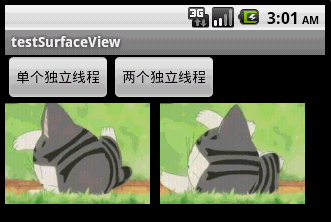本文来自http://blog.csdn.net/hellogv/ ,引用必须注明出处!
上一篇简单介绍了SurfaceView的基本使用,这次就介绍SurfaceView与多线程的混搭。SurfaceView与多线程混搭,是为了防止动画闪烁而实现的一种多线程应用。android的多线程用法与JAVA的多线程用法完全一样,本文不做多线程方面的介绍了。直接讲解SurfaceView与多线程的混合使用,即开一条线程专门读取图片,另外一条线程专门绘图。
本文程序运行截图如下,左边是开单个线程读取并绘图,右边是开两个线程,一个专门读取图片,一个专门绘图:

对比一下,右边动画的帧速明显比左边的快,左右两者都没使用Thread.sleep()。为什么要开两个线程一个读一个画,而不去开两个线程像左边那样都“边读边画”呢?因为SurfaceView每次绘图都会锁定Canvas,也就是说同一片区域这次没画完下次就不能画,因此要提高动画播放的效率,就得开一条线程专门画图,开另外一条线程做预处理的工作。
main.xml的源码:
<?xml version="1.0" encoding="utf-8"?><LinearLayout xmlns:android="http://schemas.android.com/apk/res/android" android:layout_width="fill_parent" android:layout_height="fill_parent" android:orientation="vertical"> <LinearLayout android:id="@+id/LinearLayout01" android:layout_width="wrap_content" android:layout_height="wrap_content"> <Button android:id="@+id/Button01" android:layout_width="wrap_content" android:layout_height="wrap_content" android:text="单个独立线程"></Button> <Button android:id="@+id/Button02" android:layout_width="wrap_content" android:layout_height="wrap_content" android:text="两个独立线程"></Button> </LinearLayout> <SurfaceView android:id="@+id/SurfaceView01" android:layout_width="fill_parent" android:layout_height="fill_parent"></SurfaceView></LinearLayout>
本文程序的源码:
package com.testSurfaceView;import java.lang.reflect.Field;import java.util.ArrayList;import android.app.Activity;import android.graphics.Bitmap;import android.graphics.BitmapFactory;import android.graphics.Canvas;import android.graphics.Paint;import android.graphics.Rect;import android.os.Bundle;import android.util.Log;import android.view.SurfaceHolder;import android.view.SurfaceView;import android.view.View;import android.widget.Button;public class testSurfaceView extends Activity { /** Called when the activity is first created. */ Button btnSingleThread, btnDoubleThread; SurfaceView sfv; SurfaceHolder sfh; ArrayList<Integer> imgList = new ArrayList<Integer>(); int imgWidth, imgHeight; Bitmap bitmap;//独立线程读取,独立线程绘图 @Override public void onCreate(Bundle savedInstanceState) { super.onCreate(savedInstanceState); setContentView(R.layout.main); btnSingleThread = (Button) this.findViewById(R.id.Button01); btnDoubleThread = (Button) this.findViewById(R.id.Button02); btnSingleThread.setOnClickListener(new ClickEvent()); btnDoubleThread.setOnClickListener(new ClickEvent()); sfv = (SurfaceView) this.findViewById(R.id.SurfaceView01); sfh = sfv.getHolder(); sfh.addCallback(new MyCallBack());// 自动运行surfaceCreated以及surfaceChanged } class ClickEvent implements View.OnClickListener { @Override public void onClick(View v) { if (v == btnSingleThread) { new Load_DrawImage(0, 0).start();//开一条线程读取并绘图 } else if (v == btnDoubleThread) { new LoadImage().start();//开一条线程读取 new DrawImage(imgWidth + 10, 0).start();//开一条线程绘图 } } } class MyCallBack implements SurfaceHolder.Callback { @Override public void surfaceChanged(SurfaceHolder holder, int format, int width, int height) { Log.i("Surface:", "Change"); } @Override public void surfaceCreated(SurfaceHolder holder) { Log.i("Surface:", "Create"); // 用反射机制来获取资源中的图片ID和尺寸 Field[] fields = R.drawable.class.getDeclaredFields(); for (Field field : fields) { if (!"icon".equals(field.getName()))// 除了icon之外的图片 { int index = 0; try { index = field.getInt(R.drawable.class); } catch (IllegalArgumentException e) { // TODO Auto-generated catch block e.printStackTrace(); } catch (IllegalAccessException e) { // TODO Auto-generated catch block e.printStackTrace(); } // 保存图片ID imgList.add(index); } } // 取得图像大小 Bitmap bmImg = BitmapFactory.decodeResource(getResources(), imgList.get(0)); imgWidth = bmImg.getWidth(); imgHeight = bmImg.getHeight(); } @Override public void surfaceDestroyed(SurfaceHolder holder) { Log.i("Surface:", "Destroy"); } } /* * 读取并显示图片的线程 */ class Load_DrawImage extends Thread { int x, y; int imgIndex = 0; public Load_DrawImage(int x, int y) { this.x = x; this.y = y; } public void run() { while (true) { Canvas c = sfh.lockCanvas(new Rect(this.x, this.y, this.x + imgWidth, this.y + imgHeight)); Bitmap bmImg = BitmapFactory.decodeResource(getResources(), imgList.get(imgIndex)); c.drawBitmap(bmImg, this.x, this.y, new Paint()); imgIndex++; if (imgIndex == imgList.size()) imgIndex = 0; sfh.unlockCanvasAndPost(c);// 更新屏幕显示内容 } } }; /* * 只负责绘图的线程 */ class DrawImage extends Thread { int x, y; public DrawImage(int x, int y) { this.x = x; this.y = y; } public void run() { while (true) { if (bitmap != null) {//如果图像有效 Canvas c = sfh.lockCanvas(new Rect(this.x, this.y, this.x + imgWidth, this.y + imgHeight)); c.drawBitmap(bitmap, this.x, this.y, new Paint()); sfh.unlockCanvasAndPost(c);// 更新屏幕显示内容 } } } }; /* * 只负责读取图片的线程 */ class LoadImage extends Thread { int imgIndex = 0; public void run() { while (true) { bitmap = BitmapFactory.decodeResource(getResources(), imgList.get(imgIndex)); imgIndex++; if (imgIndex == imgList.size())//如果到尽头则重新读取 imgIndex = 0; } } };}
再分享一下我老师大神的人工智能教程吧。零基础!通俗易懂!风趣幽默!还带黄段子!希望你也加入到我们人工智能的队伍中来!https://blog.csdn.net/jiangjunshow